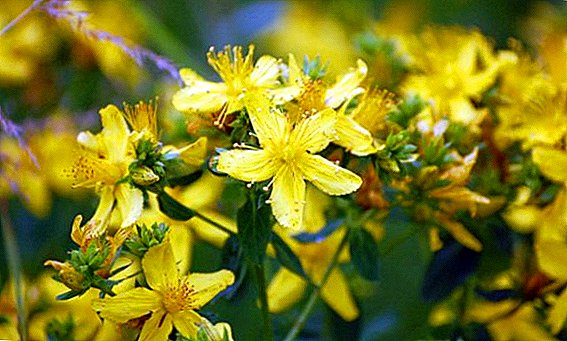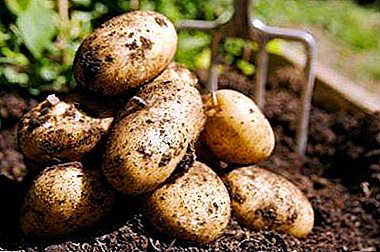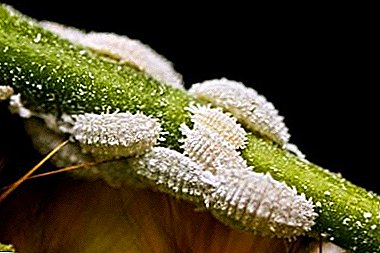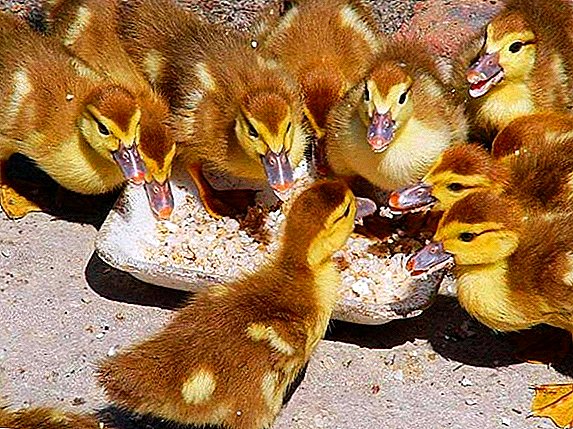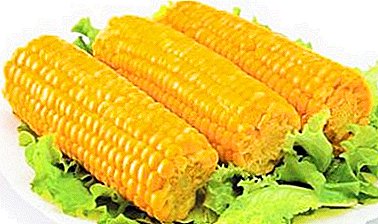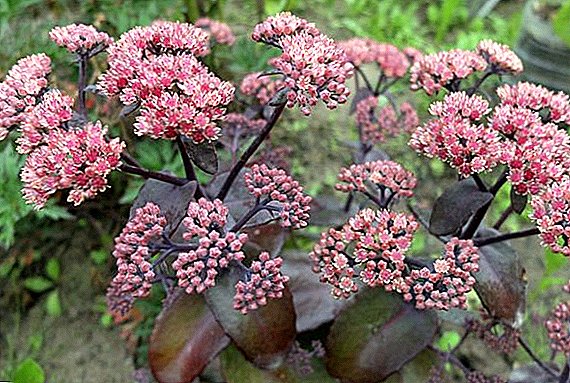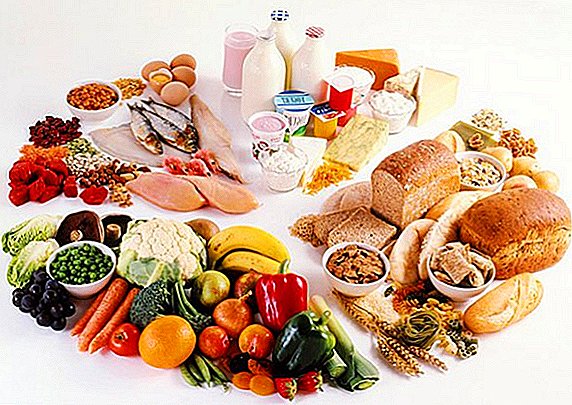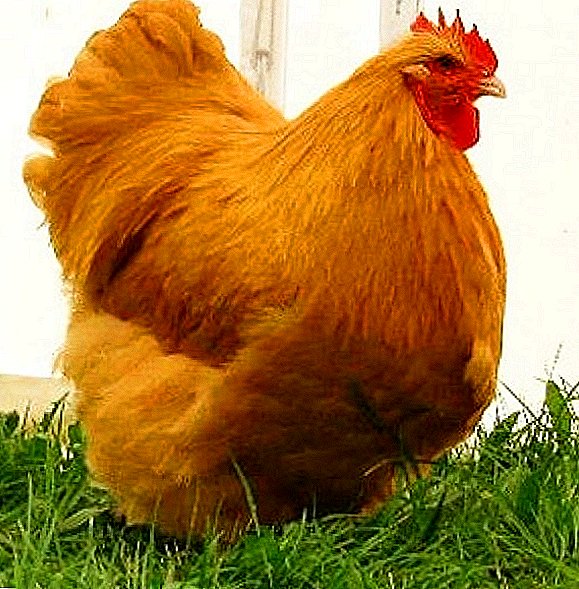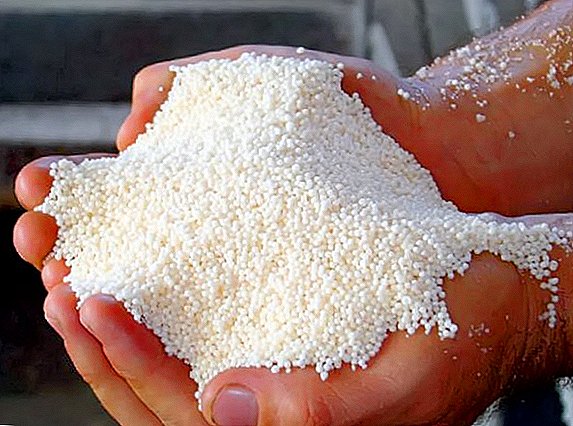 Anyone who grows vegetables or horticultural crops on his plot understands that it is very difficult to grow a generous crop without nitrogen fertilizers.
Anyone who grows vegetables or horticultural crops on his plot understands that it is very difficult to grow a generous crop without nitrogen fertilizers.
Nitrogen - This is the most important nutritional component for all crops, necessary for the rapid development of seedlings in the spring, as well as for increasing the lush hardwood.
With a lack of nitrogen, plants are weak, develop slowly and often get sick. The use of nitrogen-containing fertilizers is the easiest, fastest and most effective way to fill the shortage of this element. Therefore, in this article we will consider what nitrogen fertilizers are, what are their differences, as well as the main advantages and disadvantages of their use.
The use of nitrogen fertilizers in agriculture
 By classification distinguish nitrate nitrogen fertilizers (nitrate), ammonium and amide (urea). All of them have different properties and features of use on different soils.
By classification distinguish nitrate nitrogen fertilizers (nitrate), ammonium and amide (urea). All of them have different properties and features of use on different soils.
One of the groups of such fertilizers is nitrate (salt of nitric acid), which can be sodium, calcium and ammonium. Ammonium nitrate contains half of nitrogen in nitrate, half in ammonium form and is a universal fertilizer.
The main "competitor" of ammonium nitrate is urea, which contains almost twice as much nitrogen. Before you give preference to one or another nitrogen fertilizer, try to figure out which is better - urea or ammonium nitrate.
How to use ammonium nitrate
 Ammonium nitrate, or ammonium nitrate - mineral fertilizer in the form of white transparent granules or odorless crystals.
Ammonium nitrate, or ammonium nitrate - mineral fertilizer in the form of white transparent granules or odorless crystals.
The nitrogen content depends on the type of fertilizer and ranges from 26% to 35%.
Based on the climatic zone and soil type, various types of ammonium nitrate are used.
- Simple saltpeter. The most common fertilizer that provides intensive nutrition to plants and is used for all plants cultivated in middle latitudes.
- Mark "B". It is used mainly for fertilizing seedlings and flowers when grown indoors in the winter.
- Ammonium potassium nitrate. It is used to feed garden trees and shrubs in the spring, as well as when planting seedlings in open ground.
- Magnesium nitrate. It is used for nitrogen fertilizing vegetables and legumes. Promotes the growth of dense deciduous mass and activates the process of photosynthesis. Due to the presence of magnesium, this fertilizer is well suited for light loamy and sandy soils.
- Calcium ammonium nitrate. Fertilizer with a complex effect, positively affects plants, does not affect soil acidity, contains up to 27% nitrogen, 4% calcium, 2% magnesium.
- Calcium nitrate. Best suited for turf soil.
Practically all gardeners know what ammonium nitrate is as a fertilizer and what are the rules for its careful use in order to avoid a negative impact on a person. The application rate of any fertilizer is prescribed in the instructions on its packaging, they can not be exceeded in any case.
 Ammonium nitrate is introduced into the ground during the digging of the garden in preparation for planting. When planting seedlings in open ground, it can be used as a top dressing. If the land is not very fertile and too exhausted, the recommended dose of saltpeter is 50 g per 1 square meter. m. On a good, fertile soil - about 20-30 g per 1 square. m
Ammonium nitrate is introduced into the ground during the digging of the garden in preparation for planting. When planting seedlings in open ground, it can be used as a top dressing. If the land is not very fertile and too exhausted, the recommended dose of saltpeter is 50 g per 1 square meter. m. On a good, fertile soil - about 20-30 g per 1 square. m
When planting seedlings in open ground as a top dressing enough 1 tbsp. spoons for each seedling. Growing root crops, make additional feeding 3 weeks after germination. To do this, 1 time per season, shallow holes are made in the aisle, where ammonium nitrate is applied to about 6-8 g per 1 square meter. ground meter.
Vegetables (tomatoes, cucumbers, etc.) are fed up when planting or a week after transplantation. Thanks to the use of ammonium nitrate as a fertilizer, the plants grow stronger and increase the foliar mass. The following dressing of such fertilizers is carried out about a week before flowering.
Important! Nitrogen fertilizers should not be used during the formation of the fruit.
The use of urea in garden work
 Urea, or carbamide - fertilizer in the form of crystalline granules with a high nitrogen content (46%). This is a fairly effective dressing, with its own pros and cons.
Urea, or carbamide - fertilizer in the form of crystalline granules with a high nitrogen content (46%). This is a fairly effective dressing, with its own pros and cons.
The main difference between urea and ammonium nitrate is that urea contains twice as much nitrogen.
The nutritional properties of 1 kg of urea are equal to 3 kg of nitrate. Nitrogen in the composition of urea, easily soluble in water, while the nutrients do not go to the bottom layer of soil.
Urea is recommended to be used as foliar feeding, because when the dosage is observed, it gently acts and does not burn the leaves. This means that this fertilizer can be used during the growing season of plants, it is well suited for all types and terms of application.
- The main feeding (before sowing). Urea crystals need to be deepened 4-5 cm into the ground, as ammonia evaporates outdoors. On irrigated lands, fertilizer is applied before irrigation. In this case, the dose of urea per 100 square meters. m should be from 1.3 to 2 kg.
Important! Urea must be applied to the soil 10–15 days before sowing, so that the harmful substance biuret, which is formed during the granulation of urea, has time to dissolve. With a high content of biuret (more than 3%), the plants will die.
- Sowing dressing (during sowing). It is recommended to be applied together with potash fertilizers in order to provide a so-called layer between fertilizers and seeds. In addition, the uniform distribution of potassium fertilizers with urea helps to eliminate the negative effects that urea can have due to the presence of biuret. The dosage of urea when feeding on 10 square meters. m should be 35-65 g.

- Foliar top dressing. It is carried out by a spray in the morning or in the evening. A solution of urea (5%) does not burn the leaves, in contrast to ammonium nitrate. Dosage for foliar feeding per 100 square meters. m - 50-100 g of urea per 10 liters of water.
Urea is recommended to be used on various soils for fertilizing flowers, fruit and berry plants, vegetables and root crops.
Did you know? Urea can be used in the fight against insect pests of fruit trees. When the air temperature is not below +5 °C, but the buds on the trees have not yet dissolved, the crown is sprayed with a solution of urea (50-70 g per 1 liter of water). This will help get rid of pests that hibernate in the plant. Do not exceed the dosage of urea when spraying, it can burn leaves.
What is the difference between urea and ammonium nitrate, and what is better
 Ammonium nitrate and urea are both nitrogen fertilizers, but there is a significant difference between them. First, they have a different percentage of nitrogen in the composition: 46% nitrogen in urea versus maximum 35% in nitre.
Ammonium nitrate and urea are both nitrogen fertilizers, but there is a significant difference between them. First, they have a different percentage of nitrogen in the composition: 46% nitrogen in urea versus maximum 35% in nitre.
Urea can be applied not only as a radical feeding, but also during the growing season of plants, while ammonium nitrate is applied only to the soil.
Urea, unlike ammonium nitrate, is a more gentle fertilizer. But the main difference is that saltpeter basically - it is a mineral compound, but urea - organic.
With the help of the root system, the plant feeds only on mineral compounds, and through the leaves both mineral and organic, but less organic ones. Urea must go a longer way before starting an active action, but it retains its nutritional effect longer.
However, this is not all the difference between urea and ammonium nitrate. Ammonium nitrate affects the acidity of the soil, unlike urea. Therefore, for use on acidic soils, as well as for plants and flowers that do not tolerate an increase in acidity, urea is much more effective.
 Due to the content of two forms of nitrogen in ammonium nitrate - ammonia and nitrate, the efficiency of feeding on different soils increases. Ammonium nitrate is highly explosive and requires special conditions of storage and transportation. Urea is sensitive only to excess moisture.
Due to the content of two forms of nitrogen in ammonium nitrate - ammonia and nitrate, the efficiency of feeding on different soils increases. Ammonium nitrate is highly explosive and requires special conditions of storage and transportation. Urea is sensitive only to excess moisture.
The advantages and disadvantages of using ammonium nitrate in the country
Among the advantages of ammonium nitrate are the following.
In terms of economy, saltpeter is more profitable for a vegetable garden, it is the cheapest fertilizer, and its consumption is 1 kg per 100 square meters. meters Ammonium nitrate can be used from early spring to late autumn. Moreover, it has one important feature - its granules burn the snow, which allows sowing fertilizer over the snow without fear of ice crust or thick snow cover.
Another positive quality saltpeter - ability to act in cold soil. Grapes, shrubs, perennial vegetables and trees are fertilized with ammonium nitrate even over frozen soil, covered with a rake. At this time, the soil, though "sleeping", is already experiencing nitrogen starvation. Organic fertilizers with frozen soil can not cope, as they begin to act when the soil warms up sufficiently. But nitrate works fine in such conditions.
 Despite the versatility and efficiency of ammonium nitrate, this fertilizer has negative sides, for example, it contraindicated for acid soils. Saltpeter must be very carefully placed between the rows so that the released ammonia will not damage the seedlings.
Despite the versatility and efficiency of ammonium nitrate, this fertilizer has negative sides, for example, it contraindicated for acid soils. Saltpeter must be very carefully placed between the rows so that the released ammonia will not damage the seedlings.
Recently, it has become difficult to buy ammonium nitrate, due to its increased explosiveness. This is especially true of gardeners who purchase fertilizer in large quantities - more than 100 kg. This fact, as well as difficulties in transportation and storage make saltpeter less convenient and more problematic for the gardener.
Pros and cons of the use of urea
Consider now all the pros and cons of urea. Among the advantages it is possible to highlight the fact that urea nitrogen is very easily and quickly absorbed by cultures. The next factor is the ability to carry out an effective foliar feeding, This is the only fertilizer that does not cause plant burns.
Urea is very effective on all soils, regardless of whether they are acidic or light, which cannot be said of ammonium nitrate. Urea demonstrates good efficacy on irrigated soils. The undoubted convenience is that urea can be made in different ways: foliar and basal and at different times.
 The disadvantages of carbamide include the fact that it needs more time to start the action. This means that it is not suitable for the rapid elimination of signs of nitrogen deficiency in plants.
The disadvantages of carbamide include the fact that it needs more time to start the action. This means that it is not suitable for the rapid elimination of signs of nitrogen deficiency in plants.
Also, carbamide is sensitive to storage conditions (is afraid of moisture). However, in comparison with the difficulties of storage of ammonium nitrate, urea brings less trouble.
If the seeds come in contact with a high concentration, there is a risk of a decrease in seedling germination. But it all depends on the root system of plants. With a developed rhizome, the harm is insignificant, and in the presence of only one root stem, like that of a beet, the plant dies completely. Urea does not work on frozen, cold soil, therefore it is not effective for early spring fertilizing.
So, after analyzing the pros and cons, choose what is best for feeding in the spring - ammonium nitrate or urea, should be based on the goals. It all depends on what goal you are pursuing when planning to apply fertilizer: to accelerate the growth of the plant and the hardwood mass or to improve the quality and size of the fruit. For the quick forcing of plantings to growth, it is better to use ammonium nitrate, and to improve the quality and size of the fruit - urea.



